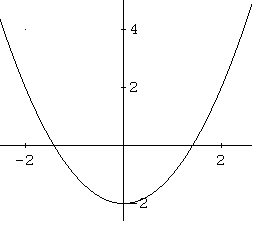Domain and Range of a Function
A step by step tutorial, with detailed solutions, on how to find the domain and range of real valued functions is presented. First the definitions of these two concepts are presented. A table of domain and range of basic functions might be useful to answer the questions below.
Definition of the Domain of a Function
For a function \( f \) defined by an expression with variable \( x \), the implied domain of \( f \) is the set of all real numbers variable \( x \) can take such that the expression defining the function is real. The domain can also be given explicitly.
also
Step by Step Calculator to Find Domain of a Function
Definition of the Range of a Function
The range of \( f \) is the set of all values that the function takes when \( x \) takes values in the domain.
Also
a Step by Step Calculator to Find Range of a Function is included in this website.
Examples with Detailed Solutions
Example 1
Find the domain of function \( f \) defined by
\[ f(x) = \dfrac{1}{x-1} \]
Solution to Example 1
\( x \) can take any real number except 1 since \( x = 1 \) would make the denominator equal to zero and the division by zero is not allowed in mathematics. Hence the domain in interval notation is given by the set
\( (- \infty, 1) \cup (1, + \infty) \)
Matched Problem 1
Find the domain of function \( f \) defined by
\[ f(x) = \dfrac{-1}{x+3} \]
Answers to matched problems 1,2,3 and 4
Example 2
Find the domain of function \( f \) defined by
\[ f(x) = \sqrt{2x-8} \]
Solution to Example 2
The expression defining function \( f \) contains a square root. The expression under the radical has to satisfy the condition
\( 2x - 8 \geq 0 \) for the function to take real values.
Solve the above linear inequality
\( x \geq 4 \)
The domain, in interval notation, is given by
\( [4, +\infty) \)
Matched Problem 2
Find the domain of function \( f \) defined by:
\[ f(x) = \sqrt{-x+9} \]
Example 3
Find the domain of function \( f \) defined by:
\[ f(x) = \dfrac{\sqrt{-x}}{(x-3)(x+5)} \]
Solution to Example 3
The expression defining function \( f \) contains a square root. The expression under the radical has to satisfy the condition
\( -x \geq 0 \)
Which is equivalent to
\( x \leq 0 \)
The denominator must not be zero, hence \( x \) not equal to 3 and \( x \) not equal to -5.
The domain of \( f \) is given by
\( (-\infty, -5) \cup (-5, 0] \)
Matched Problem 3
Find the domain of function \( f \) defined by:
\[ f(x) = \dfrac{\sqrt{-x+2}}{(x+1)(x+9)} \]
Example 4
Find the range of function \( f \) defined by:
\[ f(x) = x^2 - 2 \]
Solution to Example 4
The domain of this function is the set of all real numbers. The range is the set of values that \( f(x) \) takes as \( x \) varies. If \( x \) is a real number, \( x^2 \) is either positive or zero. Hence we can write the following:
\( x^2 \geq 0 \)
Subtract - 2 to both sides to obtain
\( x^2 - 2 \geq -2 \)
The last inequality indicates that \( x^2 - 2 \) takes all values greater than or equal to - 2. The range of \( f \) is given by
\( [-2, +\infty) \)
A graph of \( f \) also helps in interpreting the range of a function. Below is shown the graph of function \( f \) given above. Note the lowest point in the graph has a \( y (= f(x) ) \) value of - 2.
Matched Problem 4
Find the range of function \( f \) defined by:
\[ f(x) = x^2 + 3 \]
More Links and References
Find domain and range of functions,
Find the range of functions,
find the domain of a function ,
Step by Step Solver to Find the Domain of the Square Root of a Linear Function,
Find the Domain of the Square Root of a Quadratic Function and mathematics tutorials and problems.

